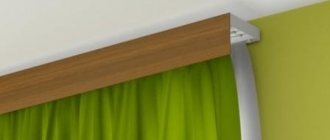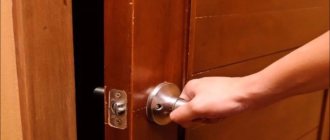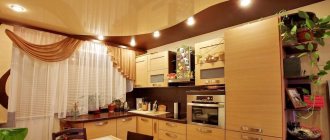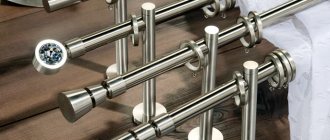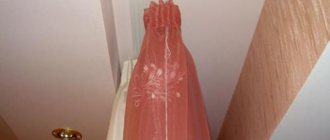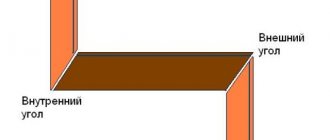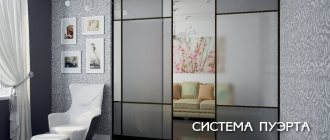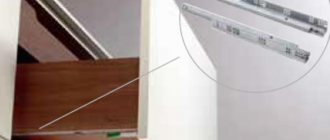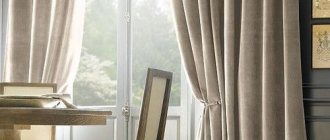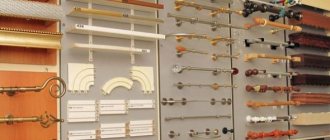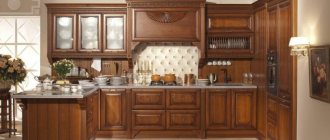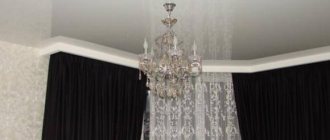17973 0 1
Icer October 22, 2016Specialization: master in the construction of plasterboard structures, finishing work and laying floor coverings. Installation of door and window units, finishing of facades, installation of electrical, plumbing and heating - I can give detailed advice on all types of work.
Today I will talk about how to install a ceiling cornice, since this type of product is one of the most popular today. We will figure out how to properly attach to various bases, and what nuances you should pay close attention to during work. After reading this review, you will be able to carry out the work yourself and achieve excellent results.
In the photo: the ceiling cornice is easy to attach and looks great
Ceiling cornice design
Before you begin work, you need to purchase a cornice; it can be sold either as a set or as individual elements, so first of all you need to figure out what parts it consists of:
This diagram shows in detail all the structural elements
| Materials | Description |
| Cornice profile | This is the main element on which the curtains are held; it can be single-row, double-row or three-row. As for color, most often it is white, but beige and brown options can be found. The manufacturing material is often plastic, but there are also aluminum products, but they are much more expensive and are not much stronger than the first option. |
| Roundings | They can be placed on the sides to give the structure greater accuracy and create a kind of frame around the window opening. They are inserted into the ends of the main profile, which is very convenient and simple |
| Straight plugs | It is used in cases where the cornice occupies the entire width of the wall. You can also use plugs if you prefer a straight cornice or there is no room for attaching curves, because they take up a certain space and increase the distance of the structure from the wall, which is not always necessary. Again, they cover the ends in curves to make them look neat |
| Connectors | They are necessary so that, if necessary, you can connect two or more main profiles. Thanks to these elements, you will not only fasten the individual parts together, but also perfectly combine them so that the curtains open and close without any obstacles |
| Stoppers | They are installed along the edges and are necessary in order to limit the movement of the hooks and prevent the curtains from crawling out of the structure. They are located on the grooves in the place you need |
| Hooks | Necessary for attaching curtains and inserted during assembly, their quantity depends on the weight of the materials that will be hung and the width of the structure, most often the elements are located in increments of 10-15 cm |
| Fasteners | Most often, the kit includes dowels, screws and plugs. From my own experience I can say that standard elements are not always suitable for use; sometimes other elements are needed |
| Decorative tape | It is needed to cover the ceiling cornice and give the structure a more attractive appearance. This element is most often purchased separately and selected depending on the interior design. If you will place the structure in a niche or a ceiling plinth will be attached in front of the cornice, then decorative tape is not needed |
Decorative ribbons can have a variety of colors and textures
When purchasing, always pay attention to the quality of the plastic; I have come across options that are made of soft material and bend very easily. So just try to bend the profile slightly, it shouldn't give way very easily.
Now let's look at such an important aspect as price, I will tell you using the example of a cornice 200 cm long, the kit usually includes the following elements:
- Double-row plastic tire;
- 4 stoppers, they are also called clamps;
- 40 curtain hooks (20 for each row);
- 2 end caps;
- Decorative baguette 50 mm wide.
The cost of such a kit starts from about 600 rubles and depends on the manufacturer and quality of the product. If you need a version with curves, then the price will be at least 200 rubles higher. The sizes available for sale most often range from 160 to 350 mm, which is quite sufficient for most window designs.
At what distance from the wall to mount
The question that arises immediately when you start installing the cornice above the window is at what distance from the corner it should be attached. Close? Stepping back 10 cm? 20 cm?
The curtain rod should be placed so that it hangs freely without touching the window sill or heating radiators.
In fact, the distance can be from 8 to 25 cm. It is determined depending on the location of the heating radiators or window sill. The cornice must be placed so that the tulle and curtains hang freely, without touching either one or the other. Firstly, this way the drapery lies perfectly, secondly, it is better for the fabrics, and thirdly, there is better air circulation, which is important during the heating season.
Structure mounting options
If you have purchased a cornice, then you need to attach it efficiently and securely; this is what will be discussed in this section. I will talk about different technologies for carrying out work, and we will figure out how to reliably fix the structure on absolutely any surface.
Moreover, I decided to take an unconventional route; we will not consider base options, but will analyze which fasteners can be used in different situations.
Option No. 1 – dowel-nails
The most traditional solution for most cases, especially when it comes to city apartments. Let's figure out how to attach a ceiling cornice to the ceiling using dowels:
- This type of fastener is suitable for concrete and other bases made of dense, homogeneous material . The principle of operation is simple: the screw expands the plastic dowel, and due to this it holds very securely;
This is the principle on which this fastener works.
- The cornice is pre-assembled, after which it must be placed evenly on the surface of the ceiling in the way it will stand. Then you need to use a pencil to mark the points where you need to drill holes. The fastening step should not be more than 60 cm, the curves are fixed with separate dowels;
Usually the product comes with a diagram with tips on the working process.
- Before attaching the structure, it is necessary to drill holes of the required diameter and depth; most often, the cornice is fixed using quick-installation dowels 6x40 mm. The work is performed with a hammer drill; it is better to work with safety glasses, since when drilling the ceiling, dust and small particles get into the eyes;
To get less debris into the room when drilling, use this simple device made from a plastic bottle
- Installation is carried out with an assistant; first you need to insert the dowels into the ceiling and push them all the way so that they do not stick out on the surface. Then one person holds the cornice on the ceiling, and the second tightens the screws, you can start from the middle, and then secure the two extreme points, after which the assistant can release the structure, and you can calmly tighten all the other screws;
One person should hold while you grab the curtain rod at several points
- After all the screws are tightened, the plugs that come with the kit are placed on the holes. It is better to do this before hanging the curtains, so that nothing interferes with the elements being inserted well.
Option No. 2 - self-tapping screws
This type of fastener is ideal for those whose ceilings are made of wood and covered with fiberboard, chipboard and other similar materials. Let's figure out how to install a cornice using self-tapping screws, everything is very simple:
- First of all, the structure is assembled. Everything is easy here, because the kit always comes with instructions;
- Then you need to make markings along the line of location of the future structure, this will allow you not to be distracted during the work process and eliminate the possibility that, due to inattention, you install the cornice crookedly. The easiest way is to put a couple of marks on the ceiling from the wall side; after attaching the cornice, they will not be visible;
- Be sure to involve an assistant, as you will not be able to attach the product and hold it at the same time;
An assistant must hold the curtain rod and ensure that it is positioned according to the marks
- For fastening, wood screws with a length of 25 mm or more are used, it all depends on the characteristics of your ceiling and its strength . The fasteners are positioned evenly and carefully screwed in until the structure is completely fixed;
You can tighten the screws with a screwdriver, but this will require some effort.
Do not overdo it: if you tighten the screws too much, they can simply crush the plastic and break it. Therefore, monitor the process, and as soon as the self-tapping screw is pressed tightly against the surface, stop working.
- At the end, I advise you to check the fasteners by slightly tugging the cornice in different places; if it holds well, then you can install plugs. If there is a loose fastening somewhere, then you need to tighten it and then close the holes with plugs.
This is what the final result looks like when using self-tapping screws
Option No. 3 - liquid nails
In this section we will figure out how to glue a cornice to the ceiling. This method has one big advantage - you don’t need power tools to work, and you don’t need to make holes in the ceiling. And one big disadvantage is that to dismantle you will have to tear off the structure, and the surface of the ceiling will have to be cleaned and refinished in any case.
As for technology, the process consists of several main stages:
- First of all, we need to purchase liquid nails; one tube is enough for our work . The cost of the compositions is low; you can buy a good adhesive for about 150-200 rubles. When choosing, give preference to well-known manufacturers who have proven themselves well among buyers and specialists;
Liquid nails “Moment” set instantly and can withstand loads of up to 90 kg per square centimeter
- The work begins with preparing the surface; it must be cleaned of dust, this will improve the strength of the fastening. If the surface is too loose and crumbles, then treat it with a strengthening primer, this will make the base much more reliable;
- Next, the cornice is assembled, here everything is done as usual, with the only difference being that you can immediately insert the plugs, because in this case we don’t need holes;
- The glue is applied in a zigzag motion over the entire surface, then the cornice is pressed against the ceiling . If the length of the structure is large, then it is better to call an assistant to do the job efficiently. Some compositions need to be left on for a couple of minutes, some set quickly, so read the instructions in advance to know how to use the glue;
The main thing is to glue the structure evenly, so watch its position
- The composition usually takes about a day to harden, after which you can hang curtains on the cornice and use it without any restrictions.
In this section, you need to deal with one more aspect. I often get the question, how to hide the cornice behind the ceiling plinth?
Everything is very simple and clear here:
- If the structure will be hidden behind the baseboard, then buy a cornice without a decorative strip . In this case, it is not needed, and you can save money;
- The baseboard is most often located in the form of a protrusion, so you will have to cut the elements at an angle to get around the cornice. To do this, it is best to use a special device called a miter box, which allows you to make perfect joints of the plinth, both on the outer and inner corners;
Using a miter box you can cut the baseboard at the perfect angle
- I think you understand how to secure the ceiling plinth in front of the cornice. To do this, its plane, which is adjacent to the ceiling, is lubricated with liquid nails and pressed against the surface. The composition holds the elements perfectly and, most importantly, neat joints at the corners; the better you combine the elements, the more attractive the end result will be.
Such a neat framing of the cornice with a plinth looks just great
Option No. 4 – dowels for drywall
Let's figure out how to attach a cornice to a plasterboard ceiling. For some reason, many people think that it is impossible to ensure reliable installation with this material, but in fact there are no problems if you know the technology and use high-quality materials and components. I will talk about two types of dowels, each of which is excellent for our purposes.
The first option is a “butterfly” type dowel; this option is called so because when fastened, its protrusions diverge like the wings of a butterfly. The fastening technology in this case is as follows:
The butterfly dowel always comes complete with a self-tapping screw.
- First of all, the cornice is assembled, after which it is applied to the place of future installation, and the places for attaching the structure are marked. Just outline the holes with a pencil, after which the cornice can be put aside for a while;
- Next, holes with a diameter of 10 mm are drilled. Drywall is easy to process, so you don’t need a drill or hammer drill; you can easily get by with a simple screwdriver with a drill of the diameter we need. During work, a lot of debris is generated, so it is better to cover the floor with film or something else;
- After the holes are ready, you need to insert the dowels into them; to do this, simply squeeze their protrusions so that they fit into the hole and push the elements until they stop. All that remains outside is a plastic cap with a hole;
- The cornice is placed against the ceiling, after which you can begin to attach it. To do this, you insert a screw into the hole and begin to tighten it; as you screw it in, it goes into the hole on the end of the dowel, and then tightens the element using the thread . The work is carried out until the protrusions on the back side of the drywall rest against the surface and fix our cornice.
This is what all the stages of fastening with this type of dowels look like:
The second type of fastener is “Driva” type dowels, you can see what they look like below, and even lower I’ll tell you how to properly fasten a cornice using them:
Another good mounting option
- First of all, it should be noted that products can be made of plastic or metal. In turn, plastic options are divided into dowels with a drill tip and products without it. In metal ones there is always a drill, and this option is much preferable, since you do not need to drill holes;
- To attach a cornice to drywall, you first need to assemble it and mark the fixation points on the ceiling;
- Then take the dowels and simply screw them into the desired points using a screwdriver. There is a cross-shaped cutout at the top end, into which it is very convenient to insert a screwdriver and tighten the element;
The dowel is simply screwed into the drywall with a screwdriver
- After all the dowels are installed in their place, you can begin to fasten the cornice; for this, one person holds it on the surface, and the second screws the screws into the prepared holes. As a result, the cornice holds firmly and reliably.
The technology is simple but very effective
Option No. 5 – brackets
If there is no way to fix the structure on the ceiling, then you will have to find a different way out of the situation. Let's figure out how to attach a ceiling cornice to the wall; this option is noticeably different from all those described above:
This is how do-it-yourself fastening work is carried out
- First you need to purchase a set of brackets, usually two pieces are enough for a cornice up to 240 cm wide, but if the structure is wider, then you need more fasteners;
The kit includes a bracket, bracket and screws for fastening it
- Then the brackets need to be attached to the cornice from its upper side. First, you should determine the position of the brackets, after which they are screwed with a screwdriver, since it is quite difficult to screw them into plastic with a screwdriver;
The staples are arranged symmetrically
- The brackets are inserted into the attached rails, after which you need to take the cornice, determine its correct position and mark the drilling locations. If you don’t know at what distance from the ceiling to hang the cornice, then first place it in different positions and find the best option. At the same time, do not forget that the structure must be located at least 10 cm above the upper edge of the opening window sashes so that the curtains do not create interference;
- The holes are drilled according to the size of the dowels you use. For work it is best to use a hammer drill. If the walls are wooden, then you don’t need to drill anything, you can simply screw the screws into the required places;
When drilling, try to keep the hammer drill perpendicular to the wall
- The brackets are fixed to the wall using dowels or self-tapping screws, they must be located at the same level, do not forget to check this aspect when drilling;
- Once the elements are securely fixed, you can begin installing the cornice. It is simply put on the holders and set in the desired position. The advantage of this option is that you can change the distance from the wall by moving the cornice along the bracket, this allows you to choose the optimal position of the structure.
At what height from the ceiling should I hang a cornice? I believe that the higher the structure is located, the better it looks
Installation on a suspended ceiling
In the case of a suspended ceiling, the ceiling cornice can only be secured to a pre-installed embedded beam. It is secured before the fabric is stretched. When fastening, use wood screws and attach them directly to the beam through the ceiling sheet.
How to attach a ceiling cornice to a suspended ceiling
The second option is a niche for installing a cornice, but this is also made during the installation of the ceiling and not later. In this case, there is also a wooden beam, but a guide for the stretch ceiling is attached to it.
Attaching a ceiling cornice in a stretch ceiling niche
There are no options for installation on a ready-made stretch ceiling. There is, however, a compromise - mounting to the wall with brackets right under the ceiling. There is a gap to the ceiling, but it is small and not too noticeable.
Conclusion
We figured out how to hang a cornice on different bases using different fastening options. You need to choose the best option and carry out the work without outside help. The video in this article will help you understand the topic even better, and if you have questions, be sure to write them in the comments under this review.
Did you like the article? Subscribe to our Yandex.Zen channel
October 22, 2016
Ceilings, Ceiling structures
If you want to express gratitude, add a clarification or objection, or ask the author something, add a comment or say thank you!
How to beautifully drape a panel?
In order for the curtain panels to form beautiful folds, you need to know how to properly hang the curtains on the cornice. The stick and string devices have rings and clips for this purpose, and the profile one is equipped with hooks. The curtains are attached to the curtain rods using these elements: the hooks can be inserted into the loops, and the clips and rings are equipped with clamps.
But in order for the curtain to lie in even waves, it is not enough to simply attach it to the cornice. Folds need to be laid either when sewing or when hanging curtains from the ceiling. In order to make a wave or gather when sewing, take 1.5-2 times more material than required by width measurements. You can make drapery when sewing like this:
- Sew curtain braid to the wrong side of the panel. It consists of a fabric tape through which strong threads are pulled. The sewn braid needs to be collected by pulling out these threads. As a result, the canvas will acquire a neat gather along the upper edge and form lush small folds.
- On the fabric, mark places for folds (counter, bow, one-sided), fold the material as required for this, and stitch it.
To hang draped curtains, you can use any type of fastener.
Folds on tulle
When hanging curtains with a straight panel, proceed differently. There is an old way to hang tulle to make the curtain look fuller. This requires an odd number of rings on the cornice. First, the tulle must be attached along the edges with 2 rings on the left and right. In this case, the sides are turned towards the window by 5-7 cm and 2 layers of fabric are clamped with a clip at once. Next you need to disassemble the rings into 2 sides. There will be 1 ring left in the center.
Find the middle of the curtain, make a small fold and secure it with a clip. On each half of the panel, do the same steps: disassemble the rings, find the center, secure with a fold. Do this until the entire top of the curtain is folded. Then stretch the tulle along the cornice.
Folds on the curtain
Even folds on a curtain suspended on a rod or string cornice can be made using the same pattern. But what if a profile cornice with hooks is installed? In this case, curtain braid will help to secure the curtains beautifully.
It needs to be sewn to the back side of the panel, but not pulled together, but use the loops that are on it. It is more convenient to first insert the hooks into the eyelets, and then hang the curtains on the ceiling cornice. Measure 10 cm from the side of the curtain and insert the hook. Bend the edge of the curtain so that this fastening element becomes the last one, and put the loop on the edge of the tape onto 1 hook with the one next to it. Do the same on the other side.
The remaining loops along the entire length of the tape should be put on hooks in pairs. As a result, the entire panel will be collected into uniform, regular folds. Their depth and number depend on how to combine the loops: in a row or with 1-2 gaps.
If the curtains on the ceiling cornice are hung correctly (with neat draping or gathering), then the appearance of the curtain will be ideal. Curtains that hang vertically can be given volume by tying them with tiebacks. Thin curtains can be sewn in the Austrian or French style, with scallops. All these techniques help to elegantly decorate windows.
Curtain design
Criteria for choosing curtains
The usual name for curtains (cornice) also has another meaning, according to which curtains are curtains made of light and flowing material. Modern designers often include them in decoration, since with their help they can achieve comfort, harmony and a sense of celebration in the room.
In order for the purchased curtain to go well with the style and direction, you need to buy a suitable product. To do this, general factors should be taken into account:
- interior of the room;
- textile color and decorative elements. For low rooms, choose smooth curtains and light curtains instead of heavy drapes;
- functional purpose of the room;
- size and shape of the window opening.
Video on how to choose curtain rods for suspended ceilings
A variety of photos and videos in the interior will help you find a suitable curtain design.
If you decide to tackle this issue yourself, then when choosing a product, follow these tips:
- in narrow rooms with windows of irregular geometric shapes, choose wide curtain rods;
- a light curtain will visually expand the spatial boundaries of the room and make the room more comfortable;
- A simple plastic or aluminum baguette without decorative overlays or patterns will suit the minimalist direction in the interior;
- a classic interior requires luxury and wealth, so wooden cornices or steel baguettes with luxurious curtains made of expensive types of fabrics would look appropriate here;
- Art Nouveau style is emphasized by curtains in the form of panels. Despite the external severity, such products look very beautiful;
- If you are a supporter of Japanese interiors, purchase special curtain panels. Their other name is Japanese curtains.
Thus, curtains should fit laconically into the interior, combined with the rest of the decoration, furniture, accessories and decorative elements. If the room is small in size, it is better to abandon heavy drapes and curtains with ruffles, flounces and other elements that weigh down the appearance of the structure.
Methods for attaching curtain fabric
When choosing curtains, pay special attention to the methods of attaching the curtains to the curtain rod:
- with ties. Such fasteners can be made from any type of fabric, using regular tape or cord. The ties can be matched to the fabric or you can choose a shade that contrasts with the curtains. It is best to use this option for light curtains made from natural fabrics;
- on loops, which are also made of fabric. They come in different lengths and widths, solid or removable;
- on the eyelets. Such a fastening requires the presence of slits in the fabric, protected by rings through which the curtain is threaded. Thanks to the uniform arrangement of the eyelets, the folds on the curtains are neat and even;
- on the drawstring. Here the fabric itself is used without special connectors. Such curtains move silently along the cornice, since additional elements do not interfere with sliding;
- on the braid. If you choose this option for fixing the fabric, you will need to purchase more fabric, since the sewn braid, when pulled together, forms many small folds;
- on the rings. On sale you can find curtains with ready-made rings. In this case, you only need to sew on the fasteners;
- on magnets. This type of fastening can be used for any curtains, creating various interesting draperies.
When carrying out repairs and decoration of premises, do not forget that every detail can radically transform the interior. Think through your options carefully so you can make the right decision.
